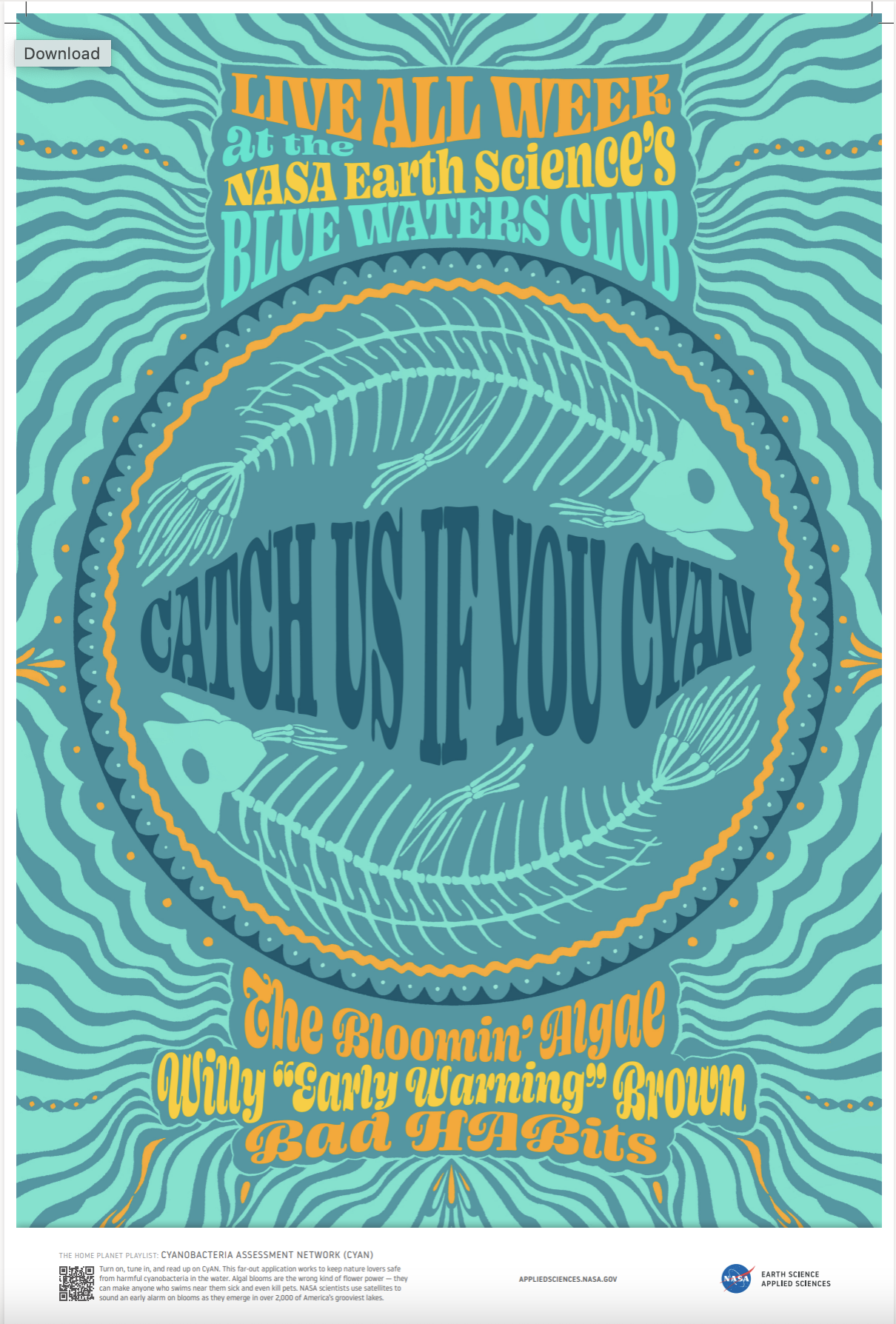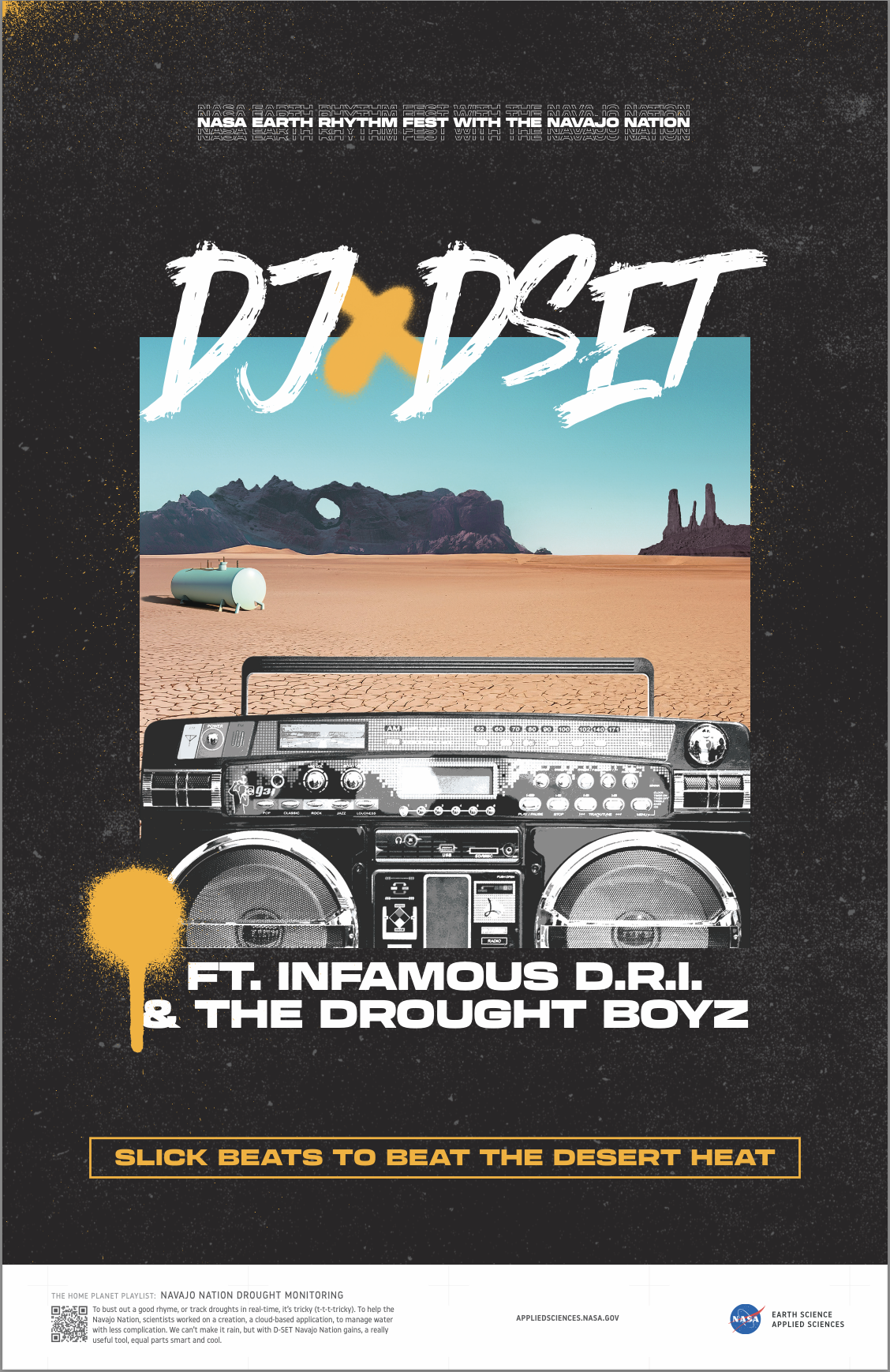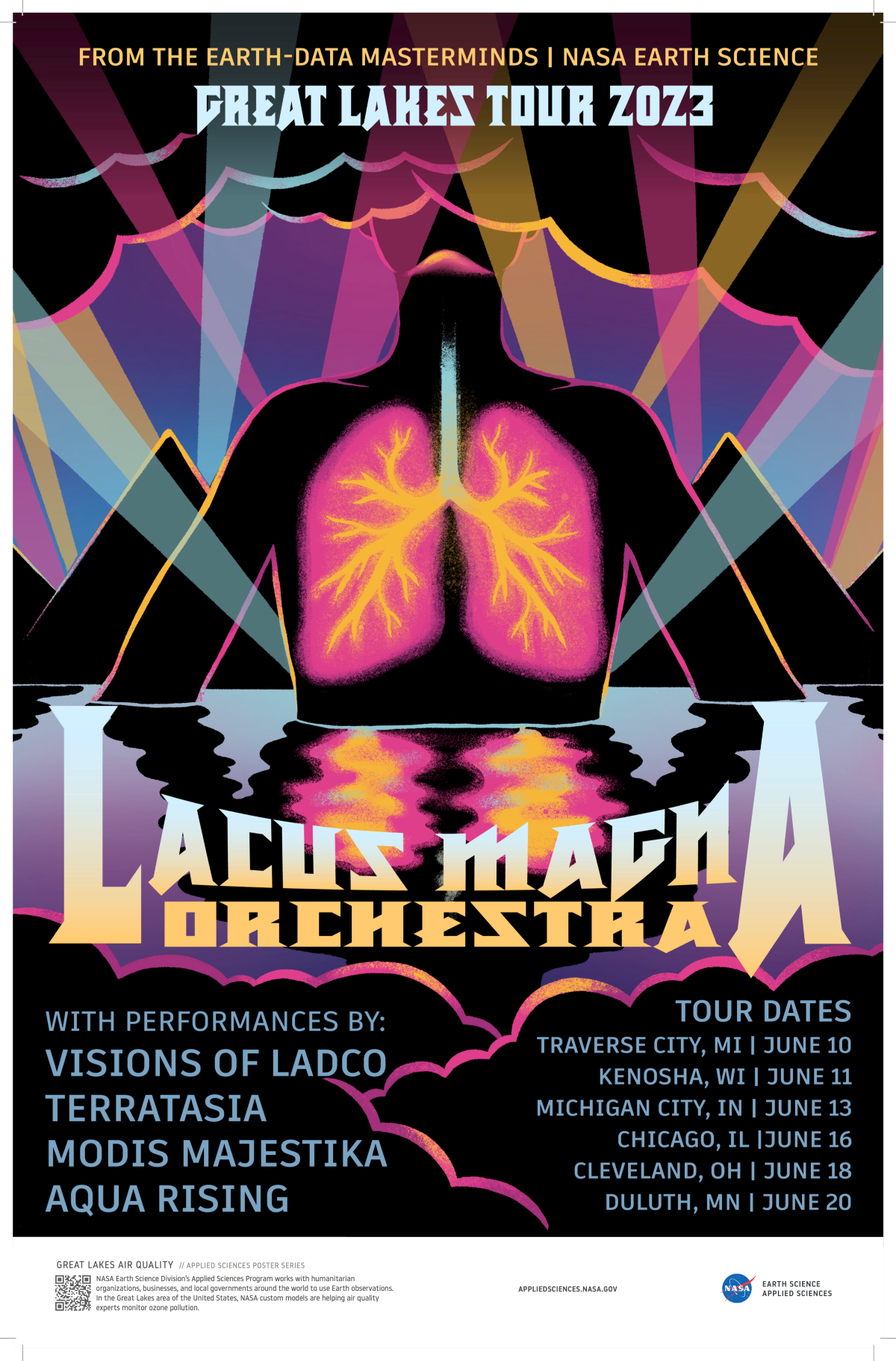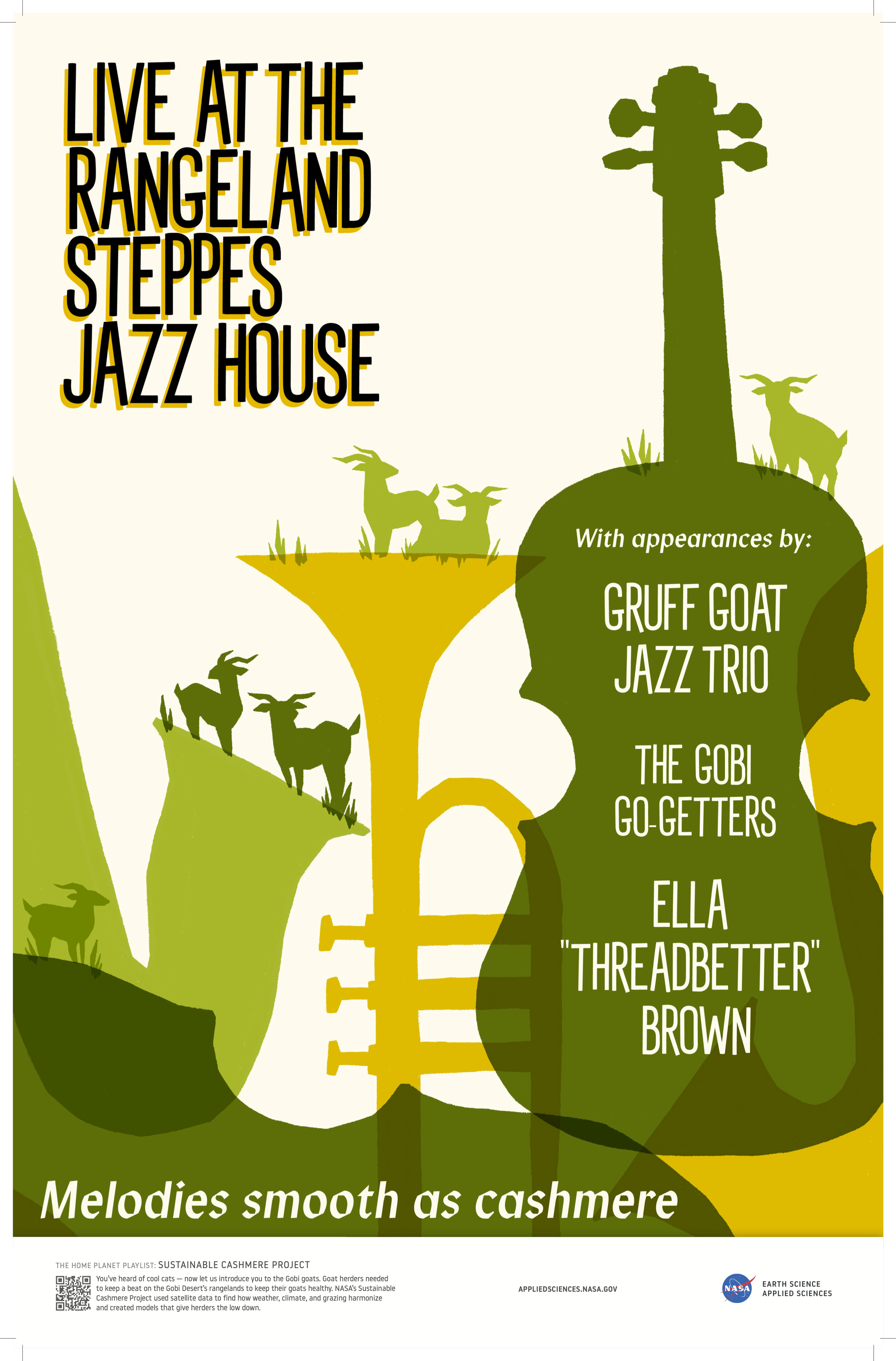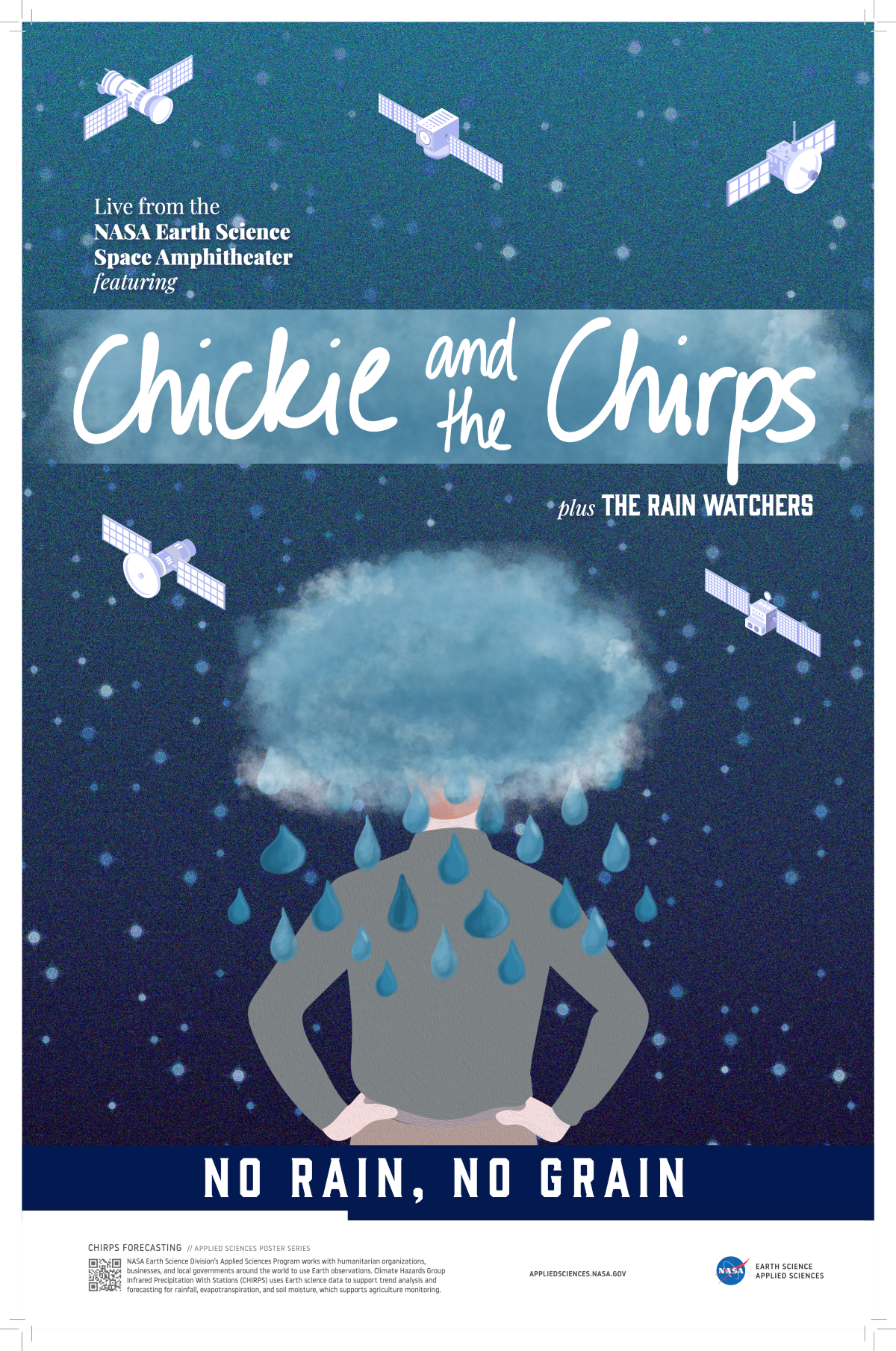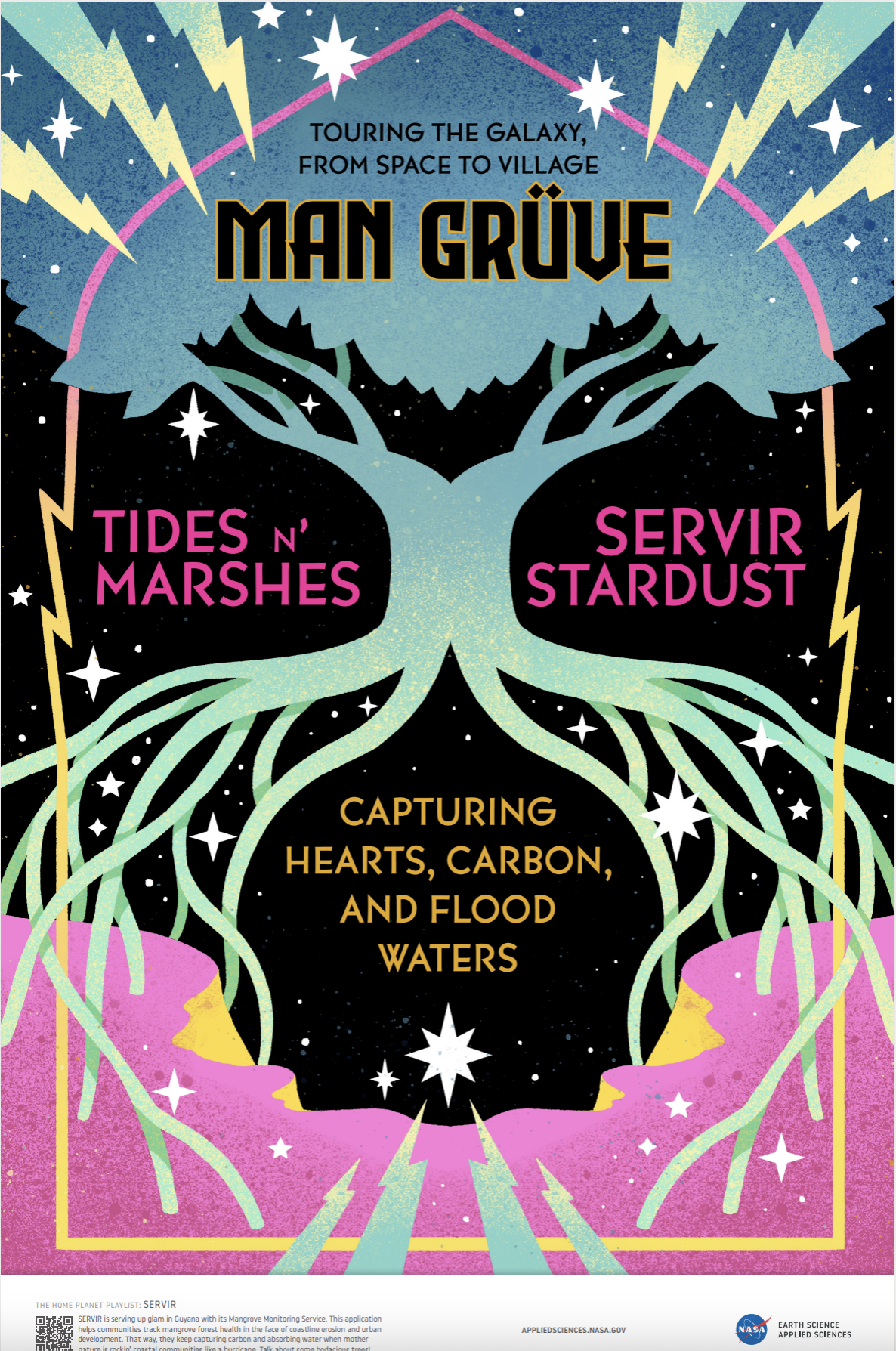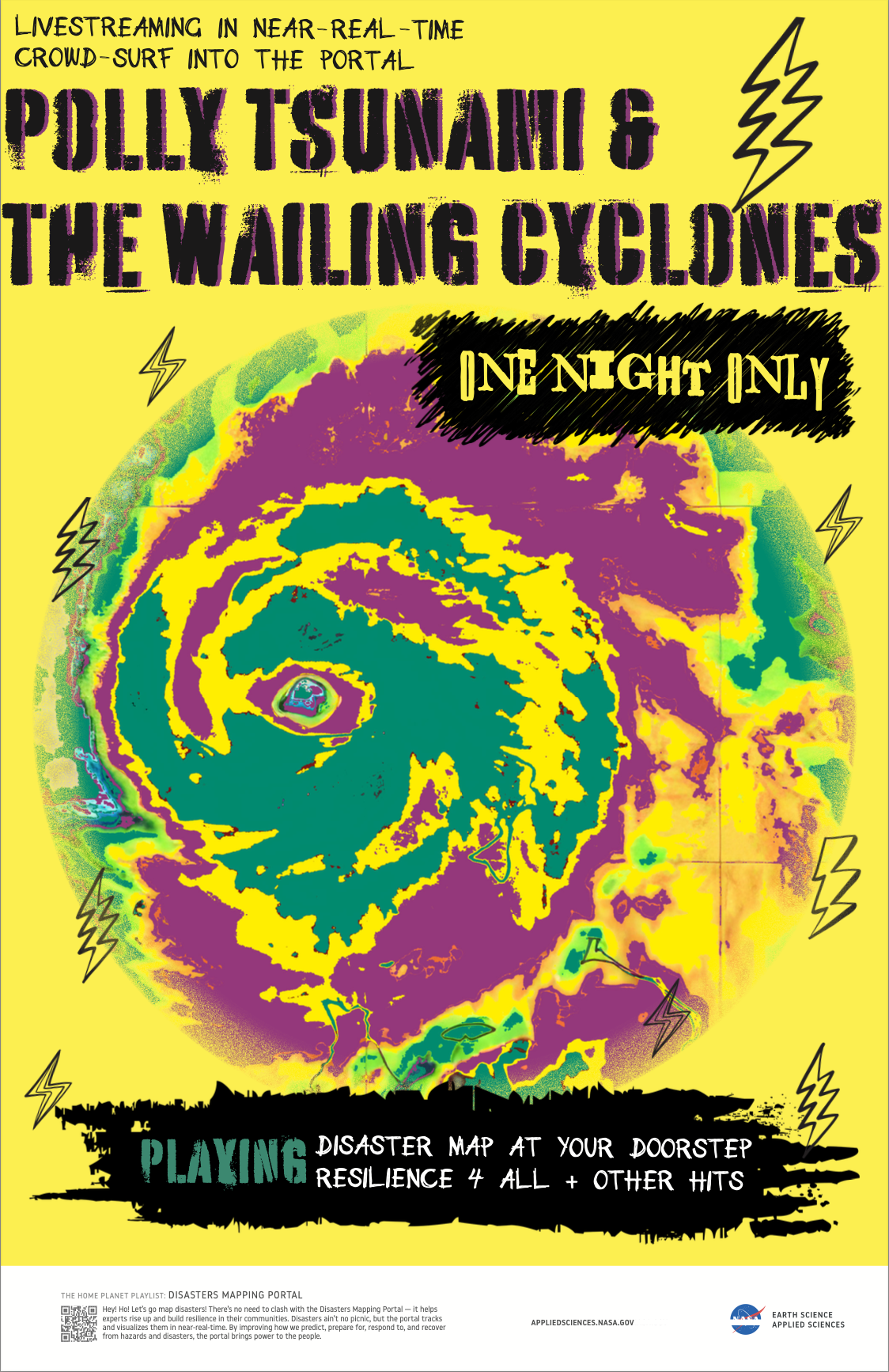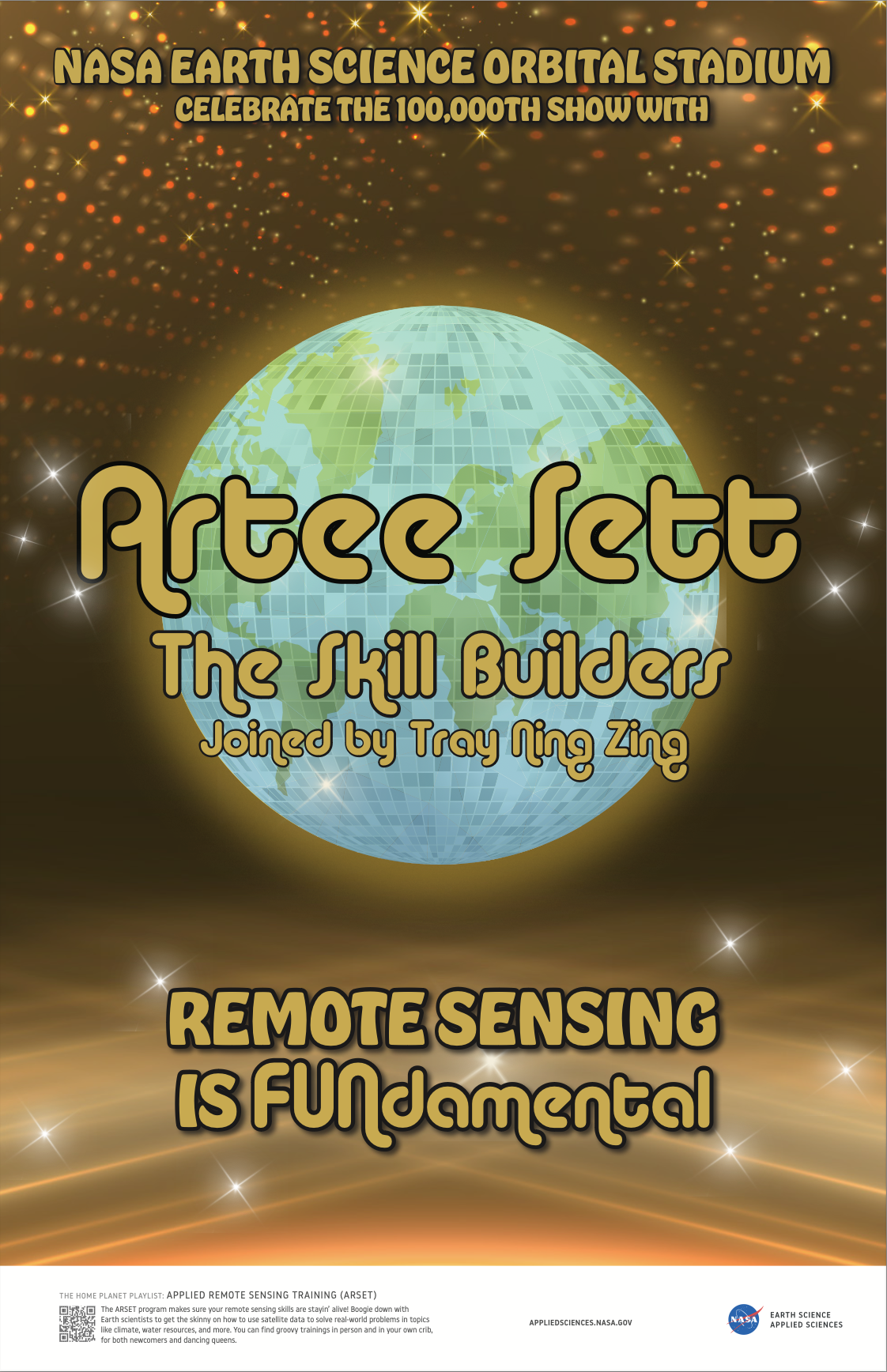If Earth science had a sound, what would it be, and what kind of artists would play it? Perhaps a jazz quartet, or a techno DJ? What would they want on their concert poster? To find out, we invite you to imagine the music while you explore our Home Planet Playlist posters.
Colorful designs and an abundance of musical word play bring to life several Earth science projects that make the world a better place. The result? A melding of art and science that looks just as cool as that vintage band poster hanging in your office. These posters are ready to go on tour and spread the word on the impact NASA science has on Earth. Be sure to download, print, and share!
GEOGLAM
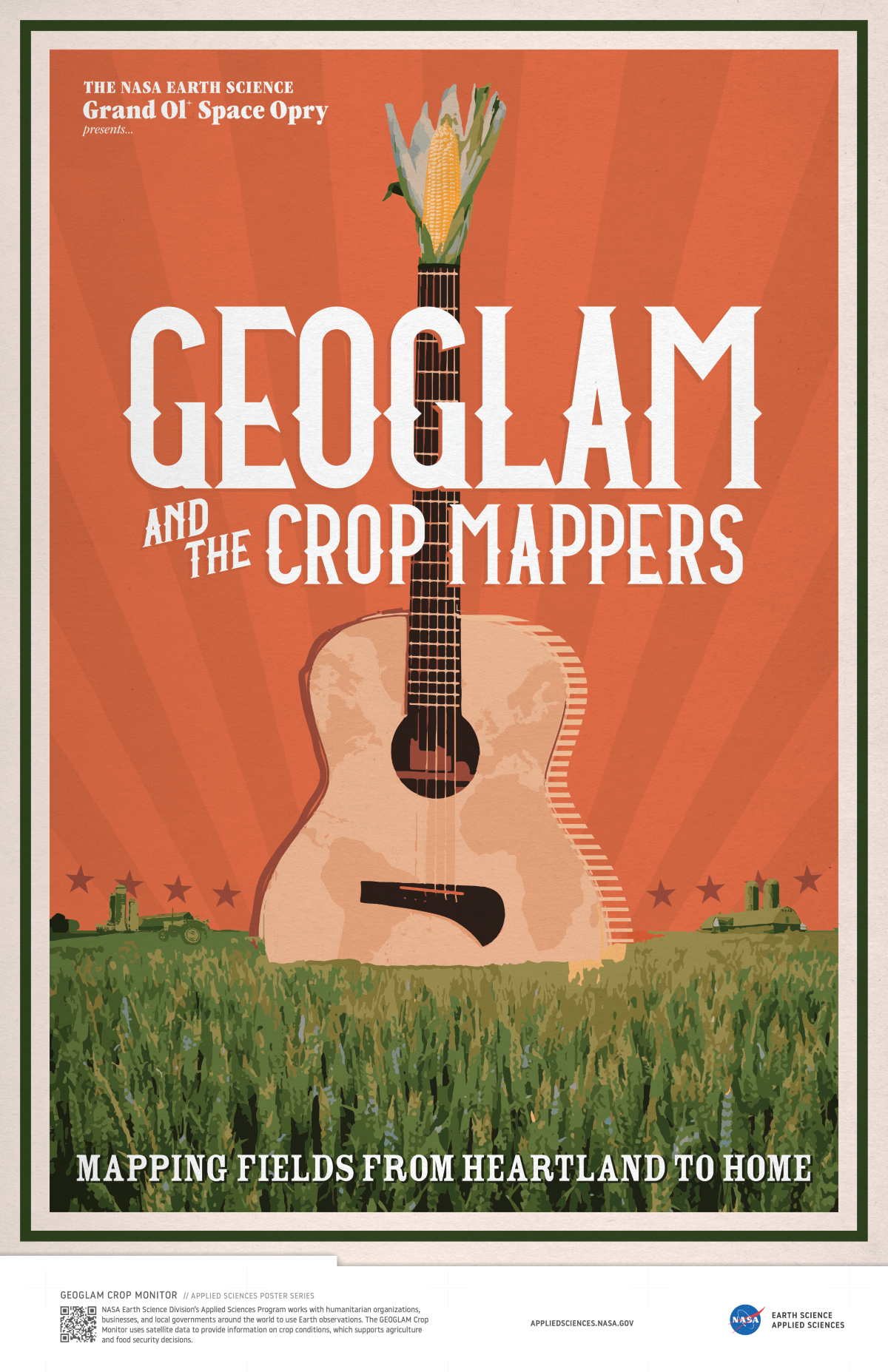
Program Area: Agriculture
Music Genre: Country
Agriculture and country music go together like biscuits and gravy. That made the genre a natural choice to feature the Group on Earth Observations Global Agricultural Monitoring (GEOGLAM) Initiative. GEOGLAM created a tool that helps both farmers and decision makers monitor crop health so they can spot concerns before they become a crisis. Called the Agrometeorological (AGMET) Earth Observation Indicators platform, it creates easy-to-read maps and graphs using satellite data.
Read about GEOGLAM
CyAN
Program Area: Water Resources
Music Genre: Psychedelic rock
From a satellite view, algal blooms look funky and cool like classic psychedelic rock posters. But you’d be safer not rocking out in blooming waters. The Cyanobacteria Assessment Network (CyAN) is a visualization tool that monitors 2,000 of America’s largest lakes for harmful algal bloom outbreaks. The early warnings it delivers allow public health and environment experts to warn the public before people and pets get sick. The app has saved millions of dollars in monitoring and healthcare costs and set a global standard for monitoring these blooms.
Read about CyAN
DEVELOP
Program Area: Capacity Building, DEVELOP
Music Genre: K-pop
What do K-pop idols and DEVELOP participants have in common? They’ve both earned a coveted opportunity to band together and show off their skills to a wider audience. DEVELOP is a workforce development program working to shape the future of science, one early-career scientist at a time. Participants conduct 10-week feasibility studies with a cohort of other scientists. Together and with the support of mentors and science advisors, they work to solve real-world challenges for end users.
Read about DEVELOP
Marine Oil Spill Thickness (MOST) Tool
Program Area: Disasters
Music Genre: Pop
Marine oil spills are devastating, but the way they fade from black to iridescent can be beautiful. It was that dramatic aesthetic that evoked pop diva vibes for us. While not a household name like the pop star who inspired this poster, the Marine Oil Spill Thickness (MOST) tool could top the Earth science charts. It detects oil thickness in the water, which helps response organizations focus cleanup efforts where they’re needed most.
Read about MOST
Drought Severity Evaluation Tool (DSET)
Program Area: Water Resources
Music Genre: Hip hop
We found common ground between combating severe drought and classic hip hop’s resourcefulness and perseverance.Working on solutions to combat severe drought takes resourcefulness and perseverance in the face of adversity that evokes the spirit of classic hip hop culture. NASA scientists and the Navajo Nation worked together to create the Drought Severity Evaluation Tool (DSET) as a way to track and report droughts. The cloud-based application is a helpful tool for managing resources in the semi-arid desert climate the Navajo Nation calls home.
Read about DSET
Ozone pollution monitoring in the great lakes region
Program Area: Health & Air Quality
Music Genre: Symphonic metal
Few things are more metal than using satellites to track ozone pollution and protect vulnerable populations from air quality-related respiratory problems. NASA scientists created custom models to do exactly that in the Great Lakes region (or Lacus Magna, which is wordplay on the Latin translation). With data from the Moderate Resolution Imaging Spectroradiometer (MODIS) on board NASA’s Terra and Aqua satellites, the Lake Michigan Air Directors Consortium (LADCO) have a better understanding of how variations in wind patterns and air pressure impact air quality.
Read about the Great Lakes project
Sustainable cashmere project
Program Area: Ecological Conservation
Music Genre: Jazz
Which is smoother: silky soft cashmere wool or a jazz solo? We couldn’t decide either. The scientists involved in the Sustainable Cashmere Project created models that predicted rangeland conditions based on precipitation, climate change over time, and other factors. This information helps cashmere goat herders living in Mongolia’s Gobi Desert make informed decisions that will keep their herds healthy and protect their livelihoods.
Read about the Sustainable Cashmere Project
CHIRPS Forecasting
Program Area: Agriculture
Music Genre: Indie Rock
Indie rock artists are trailblazers with big ambitions, a perfect poster inspiration for the Climate Hazards Group Infrared Precipitation with Stations (CHIRPS). The CHIRPS Forecasting tool has its head in the clouds — literally — to provide a global rainfall data set. By referencing evapotranspiration, soil moisture, and more, CHIRPS can help predict how weather and climate-related risks might impact food production in developing countries.
Read about CHIRPS
SERVIR’s Mangrove Monitoring Service
Program Area: Capacity Building, SERVIR
Music Genre: Glam rock
Is there anything bigger than ’80s hair? Maybe the larger-than-life roots of a mangrove tree. The Mangrove Monitoring Service, developed in collaboration with SERVIR’s Amazonia hub and the National Agricultural Research & Extension Institute (NAREI), helps experts in Guyana monitor mangrove forest health. This enhances their ability to manage, conserve, and restore mangrove ecosystems — which in turn protect coastlines from climate change, flooding, and sea level rise.
Read about Mangrove Monitoring Service
circuitscape & omniscape
Program Area: Ecological Conservation
Music Genre: EDM (Electronic Dance Music)
Animals know how to keep a party going as they flow from habitat to habitat, and NASA scientists are using some electrifying methods to track their movements. Circuitscape and Omniscape both take inspiration from the electrical engineering concept of circuit theory to map the pathways different species take to move between habitats. This helps conservationists do things like identify species who may be isolated within a single territory — which can cause inbreeding and genetic issues —and prioritize their conservation efforts.
Read about Circuitscape
Read about Omniscape
Disasters Mapping Portal
Program Area: Disasters
Music Genre: Punk
Helping communities stay resilient in the face of disasters is as punk as it gets. The Disasters Mapping Portal is a powerhouse tool that visualizes disasters globally in near-real-time. These visualizations improve how people predict, prepare for, respond to, and recover from hazards and disasters. The portal covers disasters like cyclones, floods, wildfires, volcanic eruptions, oil spills, and more — and it’s free for anyone to use, no login required.
Read about the Disasters Mapping Portal
The ARSET Program
Program Area: Capacity Building, ARSET
Music Genre: Disco
Ain’t no party like an ARSET party ‘cuz an ARSET party gives you invaluable training in using remote sensing data. And in July 2023, they celebrated hitting their 100,000th training participant! As Capacity Building’s training arm, ARSET builds skills and teaches participants how to solve real-world problems with datasets, web portals, and analysis tools powered by Earth observations. Trainings happen both online and in person for all different skill levels. Topics include climate, water resources, agriculture, and more.
Read about ARSET
Poster credits
Words by: Jessica Sheaves; Editor: Kaitlin Carpenter
Designs by: Chamisa Kellogg, Michael Brophy, Peyton Doyle
Producer: Aimee Levesque

